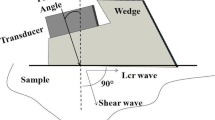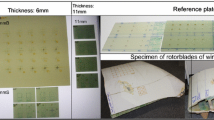Abstract
Nondestructive testing technique using T-ray (terahertz ray) has received more interest as a new capability tool in engineering application. So, T-ray time-domain spectroscopy was used for inspecting and evaluating physical property and defect characteristics in FRP composite materials for a use of wind energy. First of all, a general refraction mode and transmission mode was utilized for calculating a refractive index (n) based on the well-machined sample. In order to obtain the terahertz ray refractive index, a refractive mode and a transmission mode technique was defined for solving a refractive coefficient (n), with which refractive index of GFRP composites, balsa and epoxy for a use of wind turbine blades could be obtained. A method of wind turbine blade composites having one and two saw-cuts delaminations and some angles/directions was suggested based on the E-field vector. The time of flight in T-ray using evaluating a T-ray transmission mode agreed with that using T-ray time-domain spectroscopy with the wind turbine blade. Also, in CFRP composites, T-ray propagation is limited because the carbon fibers are blocking the T-ray. Therefore, we have analyzed difference between E-field vector in T-ray and the carbon fiber direction. Also, it was found that a T-ray time domain data in thick GFRP composite laminates seemed to show peaks with a regular spacing (Δt) which was obvious with the close relation between TOF and FFT.
Similar content being viewed by others
References
Im, K. H., Lee, K. S., Yang, I. Y., Yang, Y. J., Seo, Y. H., and Hsu, D. K., “Advanced T-ray Nondestructive Evaluation of Defects in FRP Solid Composites” Int. J. Precis. Eng. Manuf., Vol. 14, No. 6, pp. 1093–1098, 2013.
Huber, R., Brodschelm, A., Tauser, F., and Leitenstorfer, A., “Generation and Field-Resolved Detection of Femtosecond Electromagnetic Pulses Tunable up to 41 THz” Applied Physics Letters, Vol. 76, No. 22, pp. 3191–3193, 2000.
Van Rudd, J. and Mittleman, D. M., “Influence of Substrate-Lens Design in Terahertz Time-Domain Spectroscopy” JOSA B, Vol. 19, No. 2, pp. 319–329, 2002.
Bak, C., Gaunaa, M., Andersen, P. B., Buhl, T., Hansen, P., and Clemmensen, K., “Wind Tunnel Test on Airfoil RisøB118 with an Active Trailing Edge Flap” Wind Energy, Vol. 13, No. 23, pp. 207–219, 2010.
Gregory, I. S., Baker, C., Tribe, W. R., Bradley, I. V., Evans, M. J., and et al., “Optimization of Photomixers and Antennas for Continuous-Wave Terahertz Emission” IEEE Journal of Quantum Electronics, Vol. 41, No. 5, pp. 717–728, 2005.
Brown, E., Smith, F., and McIntosh, K., “Coherent MillimeterWave Generation by Heterodyne Conversion in LowTemperatureGrown GaAs Photoconductors” Journal of Applied Physics, Vol. 73, No. 3, pp. 1480–1484, 1993.
Brown, E. R., McIntosh, K. A., Nichols, K. B., and Dennis, C. L., “Photomixing up to 3.8 THz in LowTemperatureGrown GaAs” Applied Physics Letters, Vol. 66, No. 3, pp. 285–287, 1995.
Chakrapani, S. K., Daya, V., Hsu, D. K., Barnard, D. J., and Gross, A., “Characterization of Waviness in Wind Turbine Blades Using Air Coupled Ultrasonics” Review of Progress in Quantitative Nondestructive Evaluation, Vol. 30, pp. 956–962, 2011.
Hsu, D. K., Lee, K. S., Park, J. W., Woo, Y. D., and Im, K. H., “NDE Inspection of Terahertz Waves in Wind Turbine Composites” Int. J. Precis. Eng. Manuf., Vol. 13, No. 7, pp. 1183–1189, 2012.
Schueler, R., Joshi, S. P., and Schulte, K., “Damage Detection in CFRP by Electrical Conductivity Mapping” Composites Science and Technology, Vol. 61, No. 6, pp. 921–930, 2001.
Hsu, D. K., “Characterization of a Graphite/Epoxy Laminate by Electrical Resistivity Measurements” Review of Progress in Quantitative NED, Vol. 4, pp. 1219–1228, 1985.
Park, J. H., Kim, T. W., Yim, H. J., and Lee, K. S., “Characterizations of the Interfacial Energy in Glass/Resin Laminates” Int. J. Precis. Eng. Manuf., Vol. 12, No. 6, pp. 1079–1084, 2011.
Tse, K. W., Moyer, C. A., and Arajs, S., “Electrical Conductivity of Graphite Fiber-Epoxy Resin Composites” Materials Science and Engineering, Vol. 49, No. 1, pp. 41–46, 1981.
Im, K. H. and Hsu, D. K., “Evaluation and Application of T-ray Nondestructive Characterization of FRP Composite Materials” Journal of the Korean Society for Nondestructive Testing, Vol. 30, No. 5, pp. 429–436, 2010.
Dornfeld, D. A., “Moving Towards Green and Sustainable Manufacturing” Int. J. Precis. Eng. Manuf., Vol. 1, No. 1, pp. 63–66, 2014.
Author information
Authors and Affiliations
Corresponding author
Rights and permissions
About this article
Cite this article
Park, JW., Im, KH., Yang, IY. et al. Terahertz radiation NDE of composite materials for wind turbine applications. Int. J. Precis. Eng. Manuf. 15, 1247–1254 (2014). https://doi.org/10.1007/s12541-014-0464-0
Received:
Revised:
Accepted:
Published:
Issue Date:
DOI: https://doi.org/10.1007/s12541-014-0464-0




